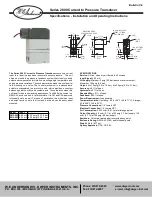
RH-10
Troubleshooting
CCS Technical Documentation
Page 10
Nokia Corporation Confidential
Issue 1 09/2002
C503, and D200. If the control voltage on pin 1 of G501 is not 2.2v, but the car-
rier is centered, then there is a problem with the VCTCXO G501. If there is 2.7v on
pin 4 and the soldering is correct, then replace G501.
5 If the carrier cannot be centered, check to see if you can adjust to 2.2v on pin 1
of G501. If you can, within the PDM range of +/- 150, then the circuitry that
delivers the voltage is working correctly, and the VCTCXO has a problem. Trouble-
shoot as described in the previous section. If you cannot adjust to 2.2v within the
accepted range, then the AFC circuitry has a problem. Troubleshoot it as
described in the previous section.
6 If there is a fault with both the AFC circuitry and the VCTCXO, then several com-
binations of the previously described conditions are possible. Start by ensuring
2.2v on pin 1 of G501, using a PDM within the range of +/- 150. Then center the
phone.
TN TX DC Offset Reference Power
Both this tuning and the next (
TN TX DC Offset Carrier Suppression
) are to adjust the
DC offset voltages on the I and Q inputs to the modulator for minimal carrier
feedthrough (maximum carrier suppression). Initially, the DC offsets are set to a nominal
value, and the power of a tone offset in frequency 20 kHz from the carrier is measured in
dBm and recorded as a reference (in this tuning). Then, in the next tuning, the carrier
suppression (delta between center tone and tone that is offset 20 kHz) is measured. If it
passes, it is reported in that tuning. If not, the DC offsets are adjusted until it passes, and
the passing value is reported.
The reported result is the power in dBm of the tone that is offset 20 kHz from the carrier,
as measured on the antenna connector, with the nominal DC offsets applied.
Manual Verification:
In Phoenix, use the RF Main Mode dialog box to set the AMPS
transmitter to channel 384. Using the RF Tuning dialog box, set the I and Q DC offsets to
0,0 by entering 0,0 in the Values edit box. Center the transmit signal on the spectrum
analyzer, set the span to 100 kHz. Lower the bandwidth so that the two sidetones can be
differentiated from the carrier. Measure the amplitude of the sidetone at 20 kHz above
the carrier. The amplitude of the sidetone will probably be higher than that of the carrier.
The amplitude should be within the test limits.
Troubleshooting:
If the carrier is not present, troubleshoot the cell TX chain using the
“things to check” list and probing table/diagrams. If the two tones offset at 20 kHz are
not present, check for them with an oscilloscope on one of the four pads of probing
point 1 in Figure 1, being very careful not to short the pad to an adjacent pad. The fre-
quency should be 20 kHz. If tone is not present on these four pads, then there is a prob-
lem with D200 (UEM). If the tones are present at probing point 1 but not on the TX
signal, check to see if they are on Robin output at L613 at 836.52 MHz + 20 kHz. If not,
there is a problem with N601 (Robin). Ensure power supplies to Robin (VR2, VR3, VR6,
and VIO) are correct. Check components around Robin. If still failing, replace Robin.











































